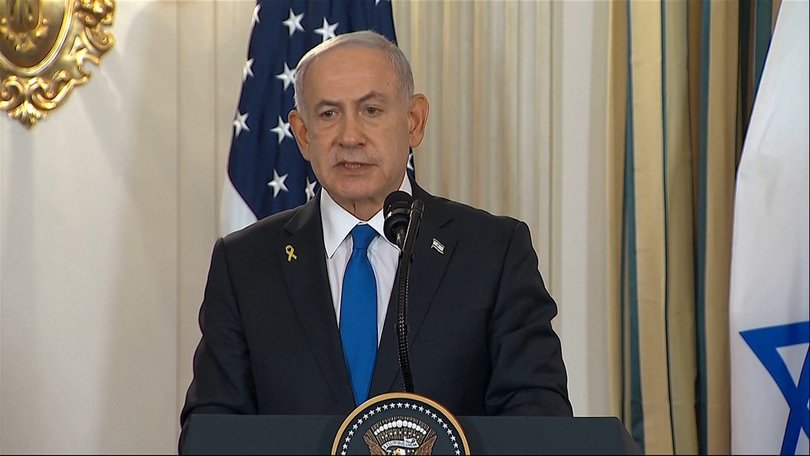THE NEW YORK TIMES: Netanyahu says Israel and Hamas are on the brink of a hostage deal

A day after Hamas signalled a willingness to release Israeli hostages as part of President Donald Trump’s ceasefire proposal, Prime Minister Benjamin Netanyahu of Israel said Saturday that he, too, hoped to finalise a deal.
In a six-minute night-time speech, he said that Israel was “on the brink of a great achievement” that could lead to the release of the remaining hostages in the Gaza Strip.
There were other positive signs. The Israeli government said Saturday that it was preparing for the “immediate implementation” of the first steps of Mr Trump’s proposal. Hours earlier, Hamas said in a statement that it was willing to release all of its remaining hostages in exchange for prisoners in Israel, a key part of the plan.
Sign up to The Nightly's newsletters.
Get the first look at the digital newspaper, curated daily stories and breaking headlines delivered to your inbox.
By continuing you agree to our Terms and Privacy Policy.But reaching an agreement to fully carry out Mr Trump’s ambitious proposal — which would compel Hamas to disarm and relinquish any role in the post-war government of Gaza — remains a serious challenge.
Mr Trump exuded confidence Friday that a deal was imminent, saying it was a “big day,” while exhorting Israel to stop bombing Gaza. But he conceded that negotiators still needed “to get the final word down in concrete.”
Hamas’ statement did not say whether it would accept many of the conditions in Mr Trump’s plan, including laying down its weapons. And it was unclear if Israel was willing to negotiate major changes to the plan’s post-war vision for Gaza, which Mr Netanyahu said he supported during a visit to the White House last week.
In his speech, in which he repeatedly rebuked those who have demanded an end to the conflict in hopes of a hostage release, Mr Netanyahu insisted that Hamas was only willing to free the hostages now because of the military and political pressure that he and Trump had applied.
“I withstood immense pressure from home and abroad to end the war,” he boasted.
Negotiations were getting back on track Saturday. The Egyptian Foreign Ministry announced that it planned to host delegations from Israel and Hamas on Monday for indirect talks.
Steve Witkoff, Mr Trump’s Middle East envoy who was involved in drafting the ceasefire plan, was expected to head to the region soon.
And mediators from Qatar and Egypt were holding their own talks with Hamas about the proposal, while the United States was speaking with Israel, according to two diplomats with knowledge of the contacts. They spoke anonymously to candidly discuss the sensitive subject.
Israelis and Palestinians were caught between disbelief, tentative hope and utter confusion after the developments, which many hoped could bring an end to the nearly two-year war.
Following Mr Trump’s demand for Israel to stop bombing, Israeli forces were instructed to shift to a defensive posture, though they generally remained in their positions, said three Israeli officials, who spoke anonymously because they were not authorized to speak publicly.
On Saturday, Mr Trump wrote in a post on social media that “Hamas must move quickly, or else all bets will be off.” He added that he would “not tolerate delay, which many think will happen, or any outcome where Gaza poses a threat again.”
But it was unclear what that meant for Palestinians in Gaza, where around 66 people were reported killed Friday, local health officials said. That toll does not distinguish between civilians and combatants.
Two Palestinians in Gaza said explosions and gunfire continued into the early morning, suggesting ongoing Israeli military activity. Avichay Adraee, an Israeli military spokesperson, warned displaced Palestinians against seizing on the optimism around a ceasefire to try to return to the north of the enclave.
Israeli soldiers “are still surrounding Gaza City, and attempting to return there poses extreme danger,” he said on social media.
Israeli forces have been conducting an operation in Gaza City that has destroyed blocks of residential neighbourhoods and forced hundreds of thousands to flee. Many Palestinians, exhausted and traumatized by the war, have said that they hope Hamas makes whatever concessions necessary to reach a deal with Israel.
“Get us out of this situation in any way possible, and quickly,” said Abdelkarim al-Harazin, a doctor who recently fled Gaza City for the south of the enclave. “We’ve been through this before, a million times, thinking that it might happen — only to get burned.”
This past week, Mr Trump unveiled a 20-point-plan to release the remaining hostages held in Gaza and to end Israel’s deadly military campaign there. At least 20 living hostages and the bodies of around 25 others are still believed to be held in Gaza.
Under the plan, Hamas would free the remaining hostages, hand over its weapons and end its rule in Gaza. Israeli forces would gradually withdraw from Gaza and allow an internationally supervised Palestinian administration to assume responsibility for public services there.
Hamas submitted its response to Mr Trump’s proposal late Friday night. In a statement, the group said it would agree to release the remaining hostages according to the terms laid out in the plan.
That would include 250 Palestinian prisoners serving life sentences in Israel, along with 1,700 others who have been detained since the start of the war. The bodies of 15 Palestinians would be exchanged for each dead Israeli captive.
But Hamas also said it wanted certain conditions on the ground to facilitate the exchange and that this arrangement would require further negotiations. The group did not address whether it would be willing to disarm, as Mr Trump’s plan envisions.
Osama Hamdan, a Hamas official, said Friday that “security measures” were needed to free the living hostages, and he suggested that locating the bodies of others would take time.
“Some have been buried, some are in areas under the occupation’s control, and some — as a result of the destruction and levelling that took place — need to be looked into,” he told Al Araby TV, a Qatar-based broadcaster.
In Tel Aviv on Saturday, thousands of people calling for a deal to secure the release of the hostages gathered in one of the largest protests that Israel has seen in months. There was an unusual atmosphere of optimism, undercut by fears that a deal would not ultimately materialize.
“The people of Israel want this deal,” Einav Zangauker, whose son Matan Zangauker is held hostage in Gaza, called out to the crowd. Addressing Netanyahu, she said, “For you, they may be just hostages, but for me, he is my child.”
This article originally appeared in The New York Times.
© 2025 The New York Times Company
Originally published on The New York Times
